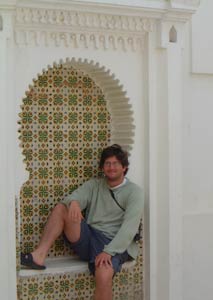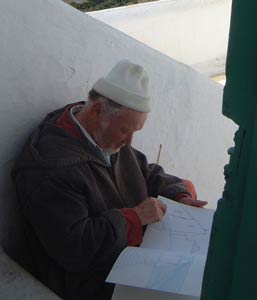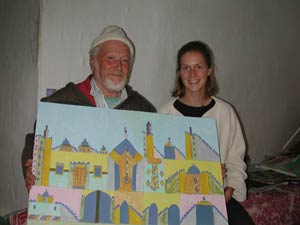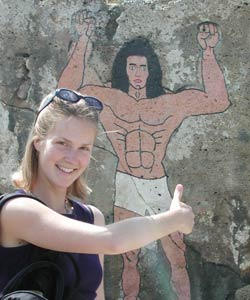|


      
|
 Inaugurated
in the 1970s, and held yearly since, Asilah's International Festival (for
arts and culture) has given the town ressources and reason to prosper.
Even in the 'off- season' (pretty much any time other than August, when
streets and hotels fill with participants to the Festival), the town is
strewn with charming restaurants, hotels, cafe terrasses- all destined
to a fickle tourist trade. Inaugurated
in the 1970s, and held yearly since, Asilah's International Festival (for
arts and culture) has given the town ressources and reason to prosper.
Even in the 'off- season' (pretty much any time other than August, when
streets and hotels fill with participants to the Festival), the town is
strewn with charming restaurants, hotels, cafe terrasses- all destined
to a fickle tourist trade.
The
medina is sparkling clean, streets of blue and green, houses shining against
a loud blue sky. Waves crashing on the remparts send smells of salt and
sand through the narrow alleys, inviting one to just sit, smell and listen.
Nothing like a good fountain to rest one's bones!
As
we wandered about, searching for Raissouni's palace (a 19th century bandit
who made his fame and fortune by kidnapping prominent foreigners), something,
or rather someone, stumbled upon us!

Ahmed
Fellah is an older man, and dutiful keeper of a tiny cemetary, overlooking
the ocean. A little stubborn he is, having us wait on the cemetary steps,
as he fumbled through his wallet. The produce of his hunt was worth the
wait- a newspaper clipping lauding his talents as a painter. We followed
him to his house- a small building he had tried to give us directions
to by flipping through his sketchbook, for a picture of his street.
We
climbed the stairs of his building, barely fitting through the narrow
door that leads into his dwellings- a few shabby rooms, tended to by a
very vociforous and very deaf elder woman. By the way she spoke to Ahmed,
I could tell she was his wife!
 Ahmed paints
like a child (big bold colorful strokes), but negotiates like a shark.
Carefully strewn about his couches are copies of the Tangiers newspaper
in which he was featured, and letters from friends in Spain, France and
the U.S, attesting to the quality of his work. Behind his innocent look
lay the shimmer of a real businessman. We laughed as he showed us through
his work, chosing those pieces he thought were best: "Hedi MEZZZIAN",
he would say, pointing to a rather abstract meddle of colors. "Yup,
that one is good"...
Ahmed paints
like a child (big bold colorful strokes), but negotiates like a shark.
Carefully strewn about his couches are copies of the Tangiers newspaper
in which he was featured, and letters from friends in Spain, France and
the U.S, attesting to the quality of his work. Behind his innocent look
lay the shimmer of a real businessman. We laughed as he showed us through
his work, chosing those pieces he thought were best: "Hedi MEZZZIAN",
he would say, pointing to a rather abstract meddle of colors. "Yup,
that one is good"...
 After
some dutiful negotiating and the usual 'ritual of the tea' I walked away
with my own original "Fellah"- a rather large painting of Assilah's
pastel streets, which I watched the artist painfully sign (as he laboriously
drew every letter of his name, tracing rather than writing, as he does
not read Roman letters). As I marched through the streets, painting under
arm, I felt quite like Hercules, having accomplished a highly treacherous
task!! After
some dutiful negotiating and the usual 'ritual of the tea' I walked away
with my own original "Fellah"- a rather large painting of Assilah's
pastel streets, which I watched the artist painfully sign (as he laboriously
drew every letter of his name, tracing rather than writing, as he does
not read Roman letters). As I marched through the streets, painting under
arm, I felt quite like Hercules, having accomplished a highly treacherous
task!!
|